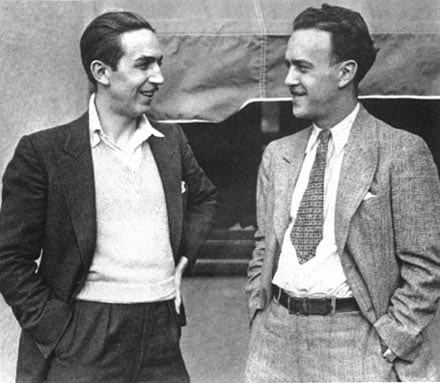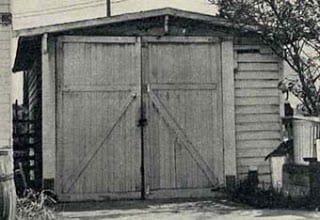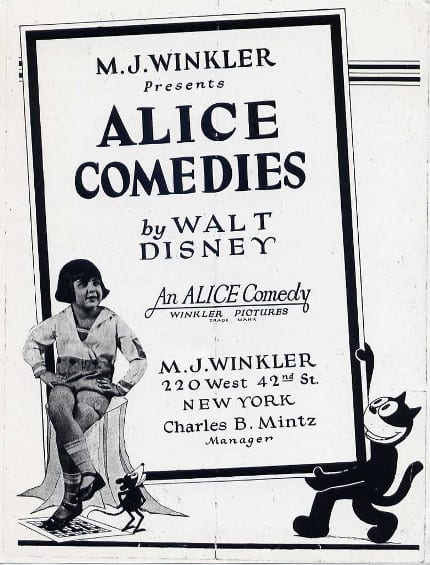Well we are now on to week 2 of Walt Wednesday. Last week we started off with Walt’s early life. His parents and siblings, some of his inspirations that he carried on to Disneyland and when we finished last week, Walt has just me Ub Iwerks. If you missed the story, you can read it HERE.
The time was January 1920, Walt and Ub Iwerks formed a very short lived company called “Iwerks-Disney Commercial Artists”. The company started out in a bad position and Walt had to leave temporarily to earn money at the Kansas City Film Ad Company. Soon after he went to work at the Film Ad Company, Iwerks had to join him as he wasn’t able to run their business alone. It was here that Walt would be come interested in animation. He worked creating commercials based on cutout animation. You might be wondering, what is cutout animation exactly? Rather than an artist drawing the scene and then drawing the next image and so on, they use objects to create a cartoon and film each scene moving the objects. The name comes as most of the objects used were cutout of paper. Walt became so interested in animation, he was able to convince the owner of the ad company, A.V. Cauger to allow him to borrow a camera from work to experiment with and see exactly what he could do. In addition to the trial and error with the camera, Walt also read a book called Animated Cartoons: How They Are Made, Their Origin and Development by Edwin G. Lutz. Even though Walt had been working with the cutout animation he thought that cel animation had greater potential.

Walt decided it was time to open his own animation business and recruited a fellow co-worker from the ad company, Fred Harman who would become Disney’s first employee. The two men would go on to create the very well known Laugh-O-Grams. Walt began to study Aesop’s Fables as inspiration for his new adventures. The first six Laugh-O-Grams were modernized fairy tales. They were fortunate enough at the time to have a local theater owned by Frank Newman, one of the most popular “showmen” in Kansas City, show the cartoons.
The cartoons were presented as “Newman Laugh-O-Grams”. The cartoons that Walt made became widely popular in the Kansas City area. It was through the success of the cartoons that was was able to acquire his own studio that he would also call Laugh-O-Gram. With all the success he was also able to hire some more animators, including Fred Harman’s brother Hugh Harman, Rudolf Isins and his close friend and former business partner Ub Iwerks. The new studio opened on May 18, 1922. Unfortunately the studio profits were not enough to cover the high salaries Walt paid his employees and the studio became loaded with debt and had to file bankruptcy. Before the company was done, Walt finished one last short, the live-action/animation Alice’s Wonderland. It was at this time, Walt’s older brother Roy invited him to come to California. Walt earned enough money for a one-way train ticket to California, leaving his staff behind, but taking the finished reel of Alice’s Wonderland with him. It was time to take his business to the next level and set up his new studio in the movie industry’s capital city, Hollywood, California.

In October 1923, Walt and his brother Roy pooled together the money they had and set up a new cartoon studio in Hollywood. Walt and Roy created ‘The Disney Bros Cartoon Studio’ in their Uncle Robert Disney’s garage, located at 4406 Kingswell Avenue, in the Los Feliz neighborhood of Los Angeles. Walt, believing in the last short he made before leaving for California of Alice’s Wonderland, requested that the star Virginia Davis and her family move from Kansas City to Hollywood. He also asked his good friend Ub Iwerks to bring his family and also relocate to California.
During October 1923, the brothers moved to a bigger lot, located in a former real estate agency at 4651 Kingswell Avenue. On October 16, 1923, Walt Disney accepted Margaret Winkler’s, of Universal Studios’ offer to distribute the new Alice Comedies starring Virginia Davis. On a side note, while at this location Disney hired a young woman named Lillian Bounds to ink and paint celluloid. After a brief courtship, the pair married, on July 25, 1925. In January 1926, with the completion of the Disney studio on Hyperion Street, the Disney Brothers Studio’s name was changed to the Walt Disney Studio. The studio would be located in the Silver Lake district, where it remained until 1939.

The new series, Alice Comedies, proved reasonably successful. After Virginia Davis no longer played Alice, they featured both Dawn O’Day and Margie Gay in the role. Also Lois Hardwick would briefly assume the role. By the time the series ended in 1927, its focus was more on the animated characters and in particular a cat named Julius, who resembled Felix the Cat, rather than the live-action Alice.
We are going to stop here for this week, but next week we will start with the creation of a lucky rabbit and what happened to him that he was not the icon of the Disney future.
- Disney Hotel wins Marriott Hotel of the Year Award - July 26, 2024
- All-Female Classic Universal Monsters Headline HHN House - July 25, 2024
- Howl-O-Sprint – Run for Your Life: Friday, Sept. 13 - July 24, 2024





